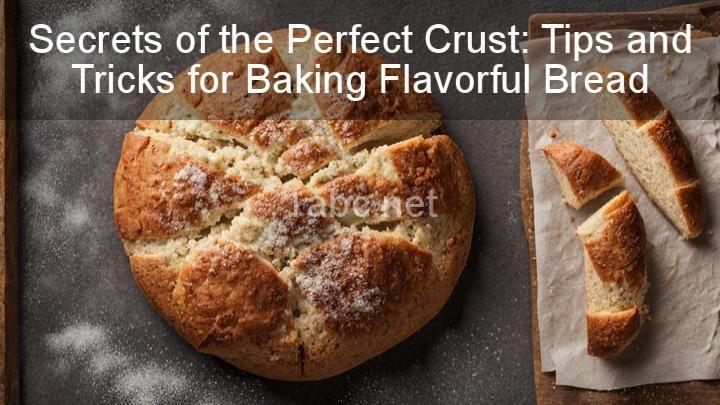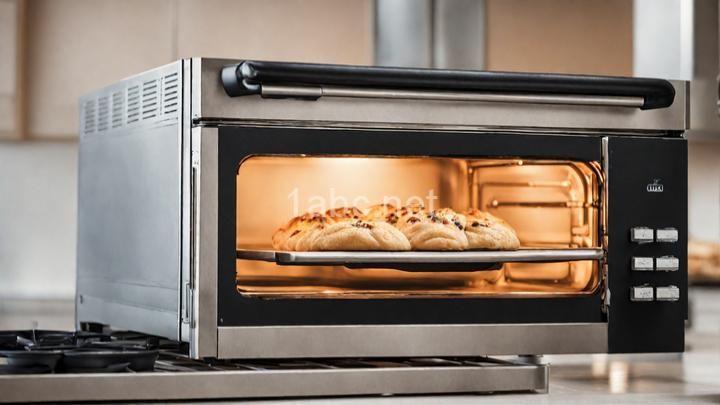Secrets of the Perfect Crust: Tips and Tricks for Baking Flavorful Bread

Introduction:
Welcome readers to the exciting world of bread baking, where we'll uncover the secrets behind creating the perfect crust. As a passionate bread baker myself, I can't wait to share with you some tips and tricks that will take your homemade bread to a whole new level. There's something truly magical about the process of making bread, and a well-developed crust plays a crucial role in elevating its flavor and texture. So, let's dive in and explore the secrets of the perfect crust together!
I. Understanding the Importance of Crust:
The crust of a loaf of bread is not just a delicious outer layer; it is also an essential element that contributes to the overall flavor and texture of the bread. A perfectly baked crust adds depth and complexity to the taste, while also providing a satisfying crunch or chewiness, depending on your preference. It is the first thing we notice when we bite into a slice of bread, and it sets the stage for the whole eating experience.
II. Selecting the Right Flour:
When it comes to achieving a flavorful crust, the type of flour you choose plays a significant role. Different flours have varying protein content, which affects the structure and texture of your bread. For a crust with a rich, nutty flavor and a good chew, consider using bread flour or high-protein all-purpose flour. These flours have a higher gluten content, which helps create a strong and well-structured crust.
If you prefer a lighter, more delicate crust, you might want to experiment with pastry flour or a combination of all-purpose and cake flour. These flours have less protein, resulting in a more tender crust. Ultimately, the choice of flour depends on your personal preference and the type of bread you are baking.
III. Mastering Dough Preparation:
Preparing the dough is a crucial step in achieving a great crust. Paying attention to factors like hydration, kneading techniques, and fermentation will greatly impact the final result.
Hydration refers to the ratio of water to flour in your dough. Adjusting the hydration level can help you achieve the desired crust texture. A higher hydration dough will result in a more open and holey crumb, while a lower hydration dough will yield a denser and chewier texture. Experimenting with different hydration levels can be a fun way to discover your preferred crust texture.
Kneading the dough properly is essential for developing gluten, which gives the bread structure and strength. However, be careful not to over-knead the dough, as this can lead to a tough crust. Aim for a smooth and elastic dough that springs back when lightly pressed.
Fermentation is another critical aspect of dough preparation that contributes to a flavorful crust. Allowing the dough to rise slowly and develop flavor over time is key. Long fermentation periods not only enhance the taste but also create a beautiful, well-browned crust during baking.
IV. The Power of Heat:
Heat is a fundamental element in creating a perfect crust. The right oven temperature and positioning are crucial for achieving a beautiful, golden-brown crust.
Preheating your oven is essential to ensure the heat is evenly distributed and consistent throughout the baking process. Most bread recipes call for a high initial temperature, which helps create a burst of steam, resulting in a crispy crust. After a few minutes, the temperature is usually reduced to allow the bread to bake evenly without burning the crust.
Positioning your bread in the oven also affects the crust. Placing the bread on a baking stone or preheated cast iron skillet can mimic the effect of a brick oven and create a crust with a lovely chewiness. Experimenting with different oven positions and accessories can help you achieve the crust texture you desire.
V. Enhancing Flavor with Toppings and Additions:
Adding toppings and additions to your bread can enhance both flavor and visual appeal. Consider sprinkling seeds, such as sesame, poppy, or sunflower, onto the crust before baking. They not only add texture but also introduce a delightful nuttiness to the bread. Fresh herbs like rosemary, thyme, or basil can also infuse your bread with aromatic flavors that complement different types of bread.
Spices, such as cinnamon or cardamom, can add warmth and complexity to sweet bread, while savory glazes with olive oil, garlic, or honey can elevate the flavor of a hearty loaf. Don't be afraid to get creative and experiment with different combinations – the possibilities are endless!
VI. Techniques for Crispy vs. Chewy Crusts:
If you have a preference for either a crispy or chewy crust, there are specific techniques you can employ to achieve your desired result.
To achieve a crispy crust, consider using the steam baking method. Just before placing your bread in the oven, pour a small amount of hot water into a preheated skillet or baking dish on the bottom rack. The water will create steam, which helps develop a crisp crust. You can also mist the dough with water before baking to create a similar effect.
For a chewier crust, baking on a baking stone or preheated cast iron skillet can work wonders. These surfaces retain heat, allowing the crust to develop a lovely chewiness. Just be careful when transferring the bread onto the stone or skillet, as they can be hot.
VII. Troubleshooting Common Crust Issues:
Sometimes, despite our best efforts, we encounter challenges in achieving the perfect crust. Here are some common crust issues and troubleshooting tips to help you overcome them:
- Pale crust: If your crust turns out pale and lacks color, try increasing the oven temperature or baking the bread for a few extra minutes. You can also brush the dough with an egg wash or milk before baking to promote browning.
- Burnt crust: If your crust is getting too dark or burnt before the bread is fully baked, reduce the oven temperature or cover the bread loosely with aluminum foil halfway through baking to prevent further browning.
- Uneven browning: Uneven browning can occur due to uneven heat distribution in your oven. Rotating the bread halfway through baking can help ensure even browning. Additionally, double-check that your oven is calibrated correctly.
- Lack of crispness: If your crust lacks crispness, try baking the bread on a wire rack instead of a baking sheet. This allows air to circulate around the bread, preventing moisture buildup and resulting in a crisper crust.
Conclusion:
Congratulations, you've made it to the end of our journey into the secrets of the perfect crust! We've explored the importance of crust in bread baking, discussed the impact of different flours, and mastered the art of dough preparation. We've also learned about the power of heat, the art of enhancing flavor with toppings and additions, and techniques for achieving your desired crust texture.
Now, armed with this newfound knowledge, it's time to put it into practice. I encourage you to experiment with different techniques, flours, and flavors. Embrace the joy of bread baking and let your creativity shine. And remember, if you have any questions or want to share your baking experiences, I'm here to listen and support you on your bread-baking journey.
Happy baking!
FREQUENTLY ASKED QUESTIONS
What is Secrets of the Perfect Crust?
Secrets of the Perfect Crust refers to the techniques and tips used to create a delicious and well-executed crust for baked goods such as pies, tarts, quiches, and pizza. It involves the combination of ingredients, the right mixing technique, appropriate resting time, and the perfect baking temperature. Achieving a perfect crust requires attention to details such as the type of flour used, proper hydration, the incorporation of fats, and the method of rolling out the dough. Additionally, understanding how to handle and bake the crust in relation to the filling or toppings is also crucial. By mastering these secrets, one can create a crust that is flaky, tender, golden, and full of flavor.
How can this content help me improve my bread baking skills?
This content can help you improve your bread baking skills by providing valuable information, tips, and techniques related to bread making. It may include step-by-step instructions for different bread recipes, explanations of key ingredients and their roles, advice on dough handling and kneading techniques, troubleshooting common problems, and suggestions for enhancing the flavor and texture of your homemade bread. By following the guidance and incorporating the tips provided in this content, you can refine your bread baking skills and become more confident in producing delicious, professional-quality loaves of bread.
Are these tips and tricks suitable for beginners?
Yes, these tips and tricks are suitable for beginners. They cover a wide range of topics and are designed to provide helpful information and support for individuals who are new to these subjects. Whether you are a beginner or have some experience, you should find these tips and tricks beneficial.
What are some common mistakes to avoid when baking bread?
When baking bread, there are a few common mistakes that you should avoid to ensure a successful outcome. Here are some of them:
- Using outdated or low-quality yeast: It's important to use fresh yeast to ensure proper fermentation and rise of the dough. Check the expiration date on the yeast package and store it in a cool, dry place.
- Not measuring ingredients accurately: Baking is a science, so it's crucial to measure ingredients carefully. Use a kitchen scale for more precise measurements, especially for flour, as using too much or too little can affect the texture and structure of the bread.
- Kneading too little or too much: Kneading is essential for developing gluten, which gives bread its structure. Under-kneading can result in a dense bread, while over-kneading can make it tough. Follow the recipe's instructions for the recommended kneading time.
- Adding too much flour: Adding too much flour to the dough can make it stiff and dry. It's better to start with less flour and gradually add more as needed until the dough reaches the desired consistency.
- Not allowing enough time for proofing or rising: Proper proofing allows the yeast to do its job, resulting in a light and airy bread. Follow the recommended proofing time in the recipe and ensure the dough has doubled in size before moving on to the next step.
- Baking at the wrong temperature: Oven temperature is crucial for baking bread. Make sure to preheat your oven to the correct temperature stated in the recipe. Baking at too low a temperature can result in a doughy center, while baking at too high a temperature can lead to over-browning or even burning.
- Cutting into the bread too early: Once the bread is out of the oven, it needs time to cool and finish setting. Cutting into it too early can result in a gummy texture and prevent the bread from fully developing its flavor.
By avoiding these common mistakes and following a tried-and-true recipe, you'll be well on your way to baking delicious homemade bread.


